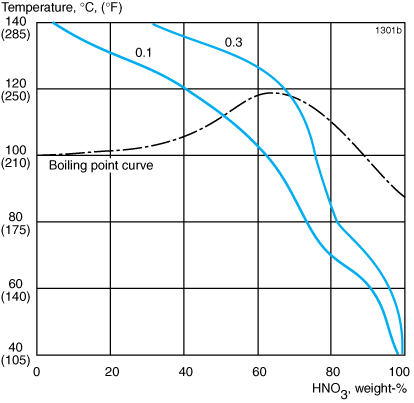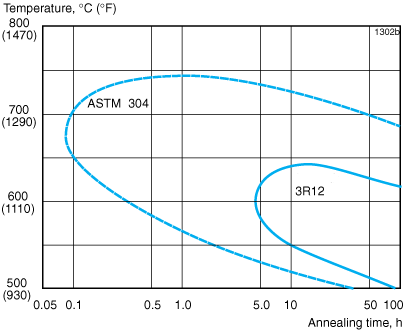Alleima® 3R12 is an austenitic stainless chromium-nickel steel with a low carbon content.
Standards
- ASTM: TP304L, TP304
- UNS: S30403, S30400
- EN Number: 1.4306, 1.4301
- W.Nr.: 1.4306*, 1.4301*
- DIN: X 2 CrNi 19 11*, X 5 CrNi 18 10*
- SS: 2352*, 2333*
- AFNOR: Z 2 CN 18.10*
- BS: 304S31*, 304S11*
- JIS: SUS304L, SUS304LTB, SUS304TP
Product standards
- ASTM A213, A269 and A312
- JIS G3459
- JIS G3463
- EN 10216-5
- BS 3605, 3606*
- DIN 17456, 17458*
- NFA 49-117, 49-217
- SS 14 23 52, 14 23 33*
* Obsolete. Replaced by EN.
Approval
JIS approval for Stainless Steel Tubes
Chemical composition (nominal)
| C | Si | Mn | P | S | Cr | Ni |
|---|---|---|---|---|---|---|
| ≤0.030 | 0.5 | 1.3 | ≤0.030 | ≤0.015 | 18.5 | 10 |
Subject to agreement, material with extra low Co content can be supplied.
Applications
Alleima® 3R12 is used for a wide range of industrial applications. Typical examples are: heat exchangers, condensers, pipelines, cooling and heating coils in the chemical, petrochemical, fertilizer, pulp and paper and nuclear power industries, as well as in the production of pharmaceuticals, foods and beverages.
Corrosion resistance
General corrosion
Alleima® 3R12 has good resistance in
- Organic acids at moderate temperatures
- Salt solutions, e.g. sulfates, sulfides and sulfites
- Caustic solutions at moderate temperatures
Alleima® 3R12 has better resistance than normal type ASTM TP304 to oxidizing agents, such as nitric acid. Figure 2 shows isocorrosion in nitric acid for Alleima® 3R12.
 Figure 2. Diagram showing isocorrosion in nitric acid for Alleima 3R12 at the corrosion rates of 0.1 mm/year (4mpy) and 0.3 mm/year (12 mpy).
Figure 2. Diagram showing isocorrosion in nitric acid for Alleima 3R12 at the corrosion rates of 0.1 mm/year (4mpy) and 0.3 mm/year (12 mpy).
Intergranular corrosion
Alleima® 3R12 has a low carbon content and therefore better resistance to intergranular corrosion than steels of type ASTM TP304.
The TTC-diagram, Figure 3, which shows the result of testing for 24 h in boiling Strauss solution (12% sulfuric acid, 6% copper sulfate) confirms the superior resistance of Alleima 3R12. This is an advantage in complicated welding operations.
The good resistance against intergranular attack of Alleima 3R12 is also demonstrated in the Huey test (boiling in 65% nitric acid for 5x48 h). A maximum corrosion rate of 0.40 mm/year in the annealed condition and 0.60 mm/year in the sensitized (675°C (1275oF)) condition can be met.
Alleima® 3R12 with its controlled and low impurity level, shows better results than ordinary ASTM TP304L or TP321.
 Figure 3. TTC-diagram for Alleima 3R12 (AISI 304L) and AISI 304.
Figure 3. TTC-diagram for Alleima 3R12 (AISI 304L) and AISI 304.
Pitting and crevice corrosion
The steel may be sensitive to pitting and crevice corrosion even in solutions of relatively low chloride content. Molybdenum-alloyed steels have better resistance improves with increasing molybdenum content.
Stress corrosion cracking
Austenitic steels are susceptible to stress corrosion cracking (SCC). This may occur at temperatures above about 60°C (140°F) if the steel is subjected to tensile stresses and at the same time comes into contact with certain solutions, particularly those containing chlorides. Such service conditions should therefore be avoided. Conditions when plants are shut down must also be considered, as the condensates which are then formed can develop conditions that leads to both stress corrosion cracking (SCC) and pitting.
In applications demanding high resistance to stress corrosion cracking (SCC) we recommend the duplex (austenitic-ferritic) steel SAF 2304.
Gas corrosion
Alleima 3R12 can be used in:
- Air up to 850°C (1560°F)
- Steam up to 750°C (1380°F)
- Synthesis gas (ammonia synthesis) up to about 550°C (1020°F).
Creep behavior should also be taken into account when using the Alleima 3R12 in the creep range.
In flue gases containing sulfur, the corrosion resistance is reduced. In such environments the steel can be used at temperatures up to 600-750°C (1110-1380°F) depending on service conditions. Factors to consider are whether the atmosphere is oxidizing or reducing, i.e. the oxygen content, and whether impurities such as sodium and vanadium are present.
Bending
Annealing after cold bending is not normally necessary, but this point must be decided with regard to the degree of bending and the operating conditions. Heat treatment, if any, should take the form of stress relieving or solution annealing, see under 'Heat treatment'.
Hot bending is carried out at 1100-850°C (2010-1560°F) and should be followed by solution annealing.
Forms of supply
Seamless tube and pipe in Alleima® 3R12 is supplied in dimensions up to 260 mm (10.2 in.) outside diameter in the solution-annealed and white-pickled condition or solution annealed by a bright-annealing process. U-bent tubes can be supplied on request.
Heat treatment
Tubes in Alleima® 3R12 are normally delivered in heat treated condition. If additional heat treatment is needed after further processing the following is recommended.
Stress relieving
850-950°C (1560-1740°F), cooling in air.
Solution annealing
1000-1100°C (1830-2010°F), rapid cooling in air or water.
Mechanical properties
For tube and pipe with wall thickness greater than 10 mm (0.4 in.) the proof strength may fall short of the stated value by about 10 MPa (1.4 ksi).
| Proof strength | Tensile strength | Elong. | Hardness | ||
|---|---|---|---|---|---|
| Rp0.2a) | Rp1.0a) | Rm | Ab) | A2" |
HRB |
| MPa | MPa | MPa | % | % | |
| ≥210 | ≥240 | 515-680 | ≥45 | ≥35 | ≤90 |
| Proof strength | Tensile strength | Elong. | Hardness | ||
|---|---|---|---|---|---|
| Rp0.2a) | Rp1.0a) | Rm | Ab) | A2" | HRB |
| ksi | ksi | ksi | % | % | |
| ≥30 | ≥35 | 75-99 | ≥44 | ≥35 | ≤90 |
1 MPa = 1 N/mm2
a) Rp0.2 and Rp1.0 correspond to 0.2% offset and 1.0% offset yield strength, respectively.
b) Based on L0 = 5.65 √S0 where L0 is the original gauge length and S0 the original cross-section area.
Impact strength
Due to its austenitic microstructure, Alleima® 3R12 has very good impact strength, both at room temperature and at cryogenic temperatures.
Tests have demonstrated that the grade fulfils the requirements according to the European standards EN 13445-2 (UFPV-2) ( (min. 60 J (44 ft-lb) at -270 oC (-455 oF)) and EN 10216-5 (min. 60 J (44 ft-lb) at -196 oC (-320oF).
| Temperature | Proof strength | |
|---|---|---|
| Rp0.2 | Rp1.0 | |
| °C | MPa | MPa |
| 50 | ≥190 | ≥215 |
| 100 | ≥165 | ≥190 |
| 150 | ≥150 | ≥175 |
| 200 | ≥140 | ≥165 |
| 250 | ≥130 | ≥155 |
| 300 | ≥125 | ≥150 |
| 350 | ≥120 | ≥145 |
| 400 | ≥115 | ≥140 |
| 450 | ≥110 | ≥135 |
| 500 | ≥105 | ≥130 |
| 550 | ≥100 | ≥125 |
| Temperature | Proof strength | |
|---|---|---|
| Rp0.2 | Rp1.0 | |
| °F | ksi | ksi |
| 200 | ≥24 | ≥28 |
| 400 | ≥20 | ≥24 |
| 600 | ≥18 | ≥22 |
| 800 | ≥16 | ≥20 |
| 1000 | ≥15 | ≥18 |
| Temperature | 10 000 h | 100 000 h | |||
|---|---|---|---|---|---|
| °C | °F | MPa | ksi | MPa | ksi |
| 550 | 1020 | ≈195 | ≈28.3 | ≈115 | ≈16.6 |
| 575 | 1065 | ≈147 | ≈21.3 | ≈93 | ≈13.5 |
| 600 | 1110 | ≈122 | ≈17.6 | ≈74 | ≈10.7 |
| 625 | 1155 | ≈100 | ≈14.5 | ≈58 | ≈8.4 |
| 650 | 1200 | ≈79 | ≈11.5 | ≈45 | ≈6.5 |
| 675 | 1245 | ≈64 | ≈9.2 | ≈33 | ≈4.8 |
| 700 | 1290 | ≈48 | ≈7.0 | ≈23 | ≈3.3 |
Physical properties
Density: 7.9 g/cm3, 0.29 lb/in3
| Temperature, °C | W/m °C | Temperature, °F | Btu/ft h °F |
|---|---|---|---|
| 20 | 15 | 68 | 8.5 |
| 100 | 16 | 200 | 9.5 |
| 200 | 18 | 400 | 10.5 |
| 300 | 20 | 600 | 12 |
| 400 | 22 | 800 | 13 |
| 500 | 23 | 1000 | 14 |
| 600 | 25 | 1200 | 15 |
| 700 | 26 | 1300 | 15 |
| Temperature, °C | J/kg °C | Temperature, °F | Btu/lb °F |
|---|---|---|---|
| 20 | 475 | 68 | 0.11 |
| 100 | 500 | 200 | 0.12 |
| 200 | 530 | 400 | 0.13 |
| 300 | 560 | 600 | 0.13 |
| 400 | 580 | 800 | 0.14 |
| 500 | 600 | 1000 | 0.14 |
| 600 | 615 | 1200 | 0.15 |
| 700 | 625 | 1300 | 0.15 |
| Temperature, °C | Per °C | Temperature, °F | Per °F |
|---|---|---|---|
| 30-100 | 16.5 | 86-200 | 9 |
| 30-200 | 17 | 86-400 | 9.5 |
| 30-300 | 17.5 | 86-600 | 10 |
| 30-400 | 18 | 86-800 | 10 |
| 30-500 | 18.5 | 86-1000 | 10 |
| 30-600 | 18.5 | 86-1200 | 10.5 |
| 30-700 | 19 | 86-1400 | 10.5 |
1) Mean values in temperature ranges (x10-6)
| Temperature, °C | MPa | Temperature, °F | ksi |
|---|---|---|---|
| 20 | 200 | 68 | 29.0 |
| 100 | 194 | 200 | 28.2 |
| 200 | 186 | 400 | 26.9 |
| 300 | 179 | 600 | 25.8 |
| 400 | 172 | 800 | 24.7 |
| 500 | 165 | 1000 | 23.5 |
1) Modulus of elasticity, (x103)
Welding
The weldability of Alleima® 3R12 is good. Welding must be carried out without preheating and subsequent heat treatment is normally not required. Suitable methods of fusion welding are manual metal-arc welding (MMA/SMAW) and gas-shielded arc welding, with the TIG/GTAW method as first choice.
For Alleima® 3R12, heat input of <2.0 kJ/mm and interpass temperature of <150°C (300°F) are recommended.
Recommended filler metals
TIG/GTAW or MIG/GMAW welding
ISO 14343 S 19 9 L / AWS A5.9 ER308L (e.g. Exaton 19.9.L)
MMA/SMAW welding
ISO 3581 E 19 9 L R / AWS A5.4 E308L-17(e.g. Exaton 19.9.LR)
ISO 14343 S 19 9 L / AWS A5.9 ER308L (e.g. Exaton 19.9.L) wire or strip electrodes are recommended for overlay welding of tube sheets and high-pressure vessels in cases where corrosion resistance, equal to that of Alleima® 3R12, is required.
Sizes in stock
Seamless tube and pipe
Alleima® 3R12 is stocked in a wide range of sizes according to ISO and ANSI. Heat exchanger tubes are also stocked in a number of sizes as BWG-sizes. Hollow bar is stocked in a large number of sizes as SANMAC 304L (see data sheet S-1824-ENG) but on request hollow bar in 3R12 can also be supplied.
Details of our manufacturing and stock programme are given in catalogue S-110-ENG.
Disclaimer: Recommendations are for guidance only, and the suitability of a material for a specific application can be confirmed only when we know the actual service conditions. Continuous development may necessitate changes in technical data without notice. This datasheet is only valid for Alleima materials.